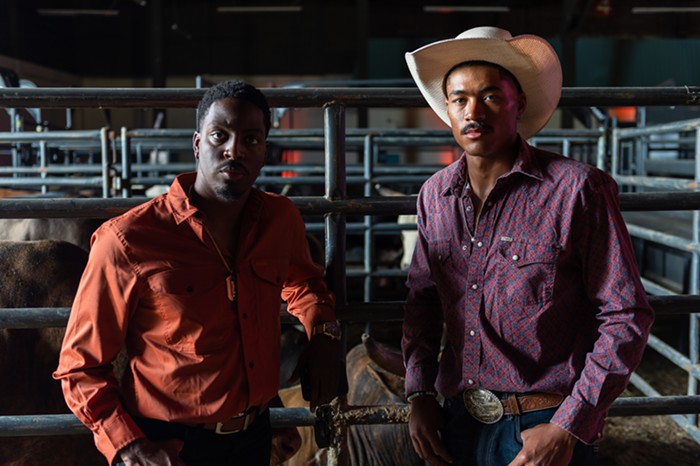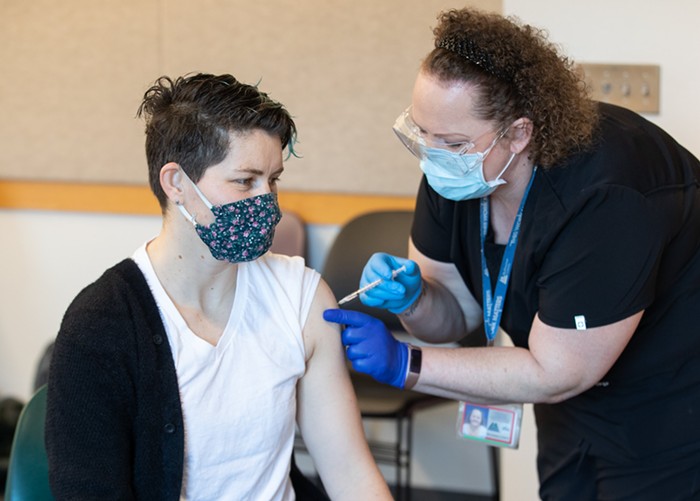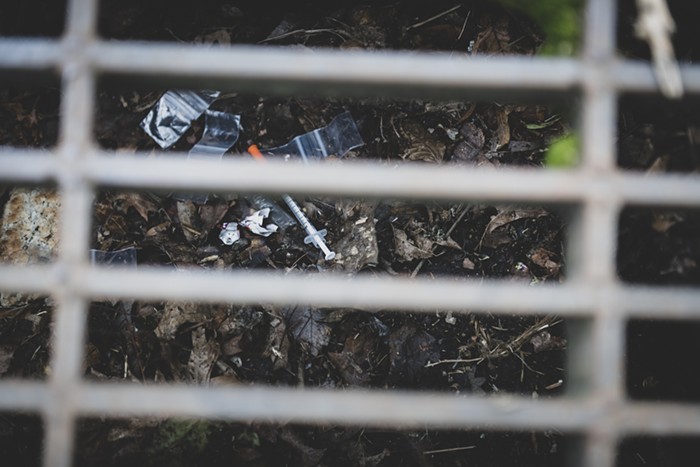
- Laura Hughes
- Laura Hughes' Passed Presence at the Portland Building
A few weeks back when I spoke with Jenene Nagy about her upcoming curatorial residence at Disjecta, I asked who she'd match up for a collaboration if she could chose any two local artists. Nagy replied, "Laura Hughes and Tahni Holt."
It just so happens that Hughes has a new show opening tonight at Appendix Space (located down the south alley between 26th and 27th avenues off of NE Alberta), and for those of you who haven't seen her work— or were curious as to why Nagy picked Hughes out of the vast array of local artists— it will be a great opportunity to see one of her site-specific installations in person.
But what do I mean when I say "site-specific installation"? Take Hughes' recent show at the Portland Building as an example: Using stationary lights and iridescent paint, Hughes created and replicated shadows cast from a handrail. The disorienting result— one shadow fanning across the wall horizontally, with others overlapping at competing angles— accounted for the many ways that light interacts with a room over the course of a day.
Tonight, Hughes will debut The Span of an Instant, continuing with her immersive style of installation. From the artist's statement:
This installation articulates and enhances fleeting instances of light in the Appendix Project Space through applications of phosphorescent and iridescent paint. It explores how light, space, time, and architectural form shape one another to produce the visible by amplifying the imprint of the peripheral to the forefront of our perception.
I emailed Hughes a few questions in order to clarify the above statement, and below are selections from our correspondence. Read on for some insight into what she'll be presenting tonight.
Mercury: How did you arrive at your current style of installation?
Laura Hughes: I’ve been a painter for several years and my interests in color and light eventually developed into constructing spatial environments. Also, my exploration of the tension between 2D and 3D architectural space is partly influenced by exposure to AutoCAD software since childhood because of my mother’s involvement in that industry.
Like your recent installation at the Portland Building, you'll be using iridescent paint to mimic the natural shadows of the Appendix garage. Will you be including any sculptural elements to anchor those shadows, or is it all paint?
It’s all pretty much paint and actual light, except for a structural modification to one wall and a light apparatus positioned outside the space.
Can you tell me about your process— how you go about creating your installations, and how you decided which shadows/interactions between light and space to represent?
Increasingly my process has become responsive to specific environments, with the majority of decisions occurring during installation. I incorporate aspects of a space that are apparent but perhaps often go unnoticed. I try to establish a relationship between what’s already there, and what I can enhance to draw the viewer in to a deeper awareness of how they experience the space.
You say your work "explores how light, space, time, and architectural form shape one another." What do you think your work says through this exploration?
There’s a level of distraction inherent in urban life that makes it difficult to really acknowledge how things around us function in our perception. My work is pointing out some of the qualities and residual effects of these aspects of our surroundings to try to bring a greater awareness to how and what we see (and experience). The great thing about art is that it slows us down to become present in a moment of reflection, which makes it an appropriate means for this pursuit.
Your most recent installation suggested the building as an abstract type of clock (the ticking rendered through interactions with light). How do you view time?— and time in relation to space?
My recent projects have used time as a means of rendering space visible. The project at Appendix does this as well, but instead of inventing a specific instant to respond to, it represents time by recording and layering actual shifting instants of light entering the space. I like to set up a situation where time and space function together so that imagery becomes gradually discernable over a period of looking.












